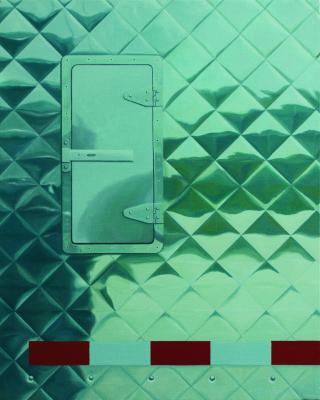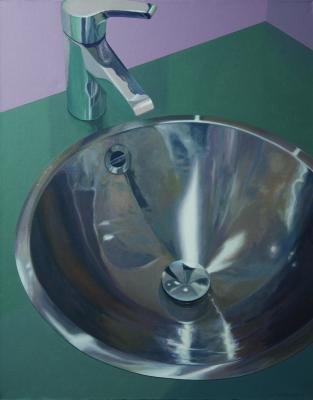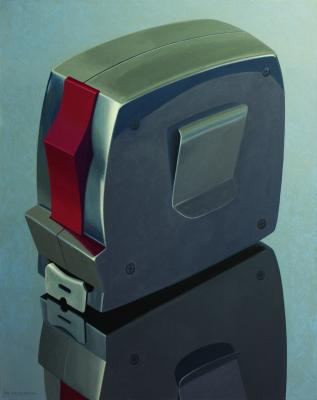On Reflection, Paradox and Ambiguity 1.11.13
-by Michael J. Krainak, Free Lance Writer in the Visual Arts
“I’m not just interested in what a thing is; I’m interested in what else it is.”
Minor White, American photographer
For most people, the first half of White’s premise would be challenging and satisfying enough, but not for him or Lincoln oil painter Merrill Peterson. It’s not that objects have no value in and of themselves, it’s the awareness all artists share that if reality is a matter of individual perception, first impressions can be remarkably inadequate. Not that they are always misleading, but to a true observer, life doesn’t really become something until one moves beyond the senses. Seeing isn’t always believing. It may be quite the opposite.
Peterson gets this, and his current exhibit of two dozens oils, On Reflection, lives up to its subtext of “Paradox and Ambiguity.” Each canvas features mostly an ordinary object in close up, either life size or larger than life, and in sharp, reflective relief or filtered and encased in its shadowing setting. It’s tempting to analyze his precise attention to detail as photo-realism, but the imagery before us is an illusion, not only one of perception but of creation, a process that began early in the artist’s life.
“An image of the impossible trident (devil’s fork) on the cover of Mad magazine in the mid-60’s. I found it fascinating but totally baffling, “says Peterson, chairman of the Graphic Design Program at Southeast Community College. “By covering a portion of the drawing it was possible to dissect how it was made, but when viewed as a whole, it remained vexing. How could this be?”
He admits to struggling with “confirmation bias,” the tendency to perceive the world in a way that confirms one’s preconceptions rather than keeping an open mind to greater depth and possibilities of insight. “Our eyes send identical signals to the brain, the brain flip-flops over the interpretation,” he explains. “My paintings attempt to challenge what I think I see and know.”
On Reflection at first glance may seem an odd and obvious representation of the mostly familiar, including an array of kitchen utensils, tools, teapots, auto parts and even the inside of public restrooms. Because we’ve seen them before, we assume we know them, and therein lies the rub. The challenges facing Peterson are similar for us when presented with the same opportunity to spend a little face time with each work in this show. Neither artist nor viewer can afford to take the object or moment for granted.
Photographer White was reported also to have said, “When you approach something to photograph it, first be still with yourself until the object of your attention affirms your presence. Then don’t leave it until you have captured its essence.” By “essence,” White could have meant any number of things from its aesthetic or functionality to something so personal or conceptual that when observed, captured or recreated, it both reduces specific objects to a level of secondary importance while yielding “an image with suggestive power that can direct the viewer into a specific and known feeling, state or place within himself.”
While White used symbols, text and sequences to create a feeling or idea for the sake of “recognition,” Peterson’s “reflections” deliberately court chaos by establishing a convincing yet misleading image through a trompe l‘ oeil technique that quite literally means “fools the eye.” Known also as illusionism, it uses linear perspective and optical science, as well as nuances of light and gradation of color and tone-all hallmarks of Peterson’s style-to render convincing openings in walls, ceilings and vessels where there are none or to depict 2D objects as three dimensional.
Why use exhausting detail and masterful sleight of hand for the sake of deception? Because, these very skills mirror closely how our senses and mind compute everyday reality beyond absolutism and preconception. “The paintings,” the artist says about this exhibit, “reflect a point of view that almost nothing is what it first appears to be. I’m interested in layers of meaning and considerations of ambiguity and paradox beyond art.”
On Reflection is organized into several series that group according to similar objects in the same or contrasting style and point of view. The use of repetition and variation within each grouping reinforces the show’s subtext and Peterson’s belief that perception, at any level, “requires careful and repeated looking on what is being reflected. It requires observing the specific rather than the general, and it requires the suspension of what I think I know about a subject.”
Especially so, Peterson says, when that object/subject is seen as a reflection on an unpredictable surface. For example, consider his three pieces devoted to teapots, “Museum Case One,” “Museum Case Two” and “U.P. Teapot.” Though similar in subject and exquisite attention to shape, tone and texture, the first teapots so recede into a geometric maze of their encasement and ambiance that they become part of their environment. The illusion is one of ghostly antiquity with its palette of silvery blues, greens and grays. The perspective is flat, yet their patterned surfaces are multidimensional and transparent not unlike a hologram, both real and ethereal.
Conversely, “U.P. Teapot” fairly floats off its canvas in its 3D elegance as it sits magisterially on its platter in the limelight. Unlike the other two teapots that appear, then seem to disappear into the background, this U.P. trophy is organic and sculptural while wearing and reflecting its setting like a royal robe. Though all three works are aesthetically pleasing, their different POV and optical effects reinforce the concept that understanding is often a matter of context and multiple interpretations. “I hope to bring together technique and idea,” Peterson says, “to create balance between the two.”
This is no more apparent than with one painting that might be considered On Reflection’s signature work, the estimable “Fork Spoon Times Two.” On an icy blue background, a fork and spoon of your finest flatware share a table setting with their mirror image. The “four” utensils appear to be suspended in space the way a viewer must suspend one’s first impression in order to grasp the reality of the image. The grace and craftsmanship here can be enjoyed for their own sake, but the painting strongly suggests how any subject requires more than a passing glance in order to perceive a greater depth of perception.
Is a utensil any more “real” than its reflection? Is “Fork Spoon Times Two” less so because it’s a painting? And more to the point, do values, whether aesthetic, moral, ethical or whatever, exist absolutely, objectively, or are they only of worth when applied or understood within the context of the moment and space of each specific example. Peterson’s work would suggest the latter. He continues to explore this theme within his most visually challenging series of optical illusions wherein various objects and their surfaces reflect their patterned surroundings and are thus anchored, even structured by them. This includes such work as “Zig Zag,” “Tablecloth & Ladle” and perhaps the most mesmerizing of all, “Staple Gun Stripes.”
In each of these paintings as well as others in this group, the reflective patterns shape and define each object organically and geometrically. There is no escaping the connection. You may never look at a common, ordinary object in the same way again anymore than one can generalize about an issue once experienced on a personal level. Peterson also revels in more uncommon things in his still lifes, especially his exquisite series devoted to auto-detailing, circa the 50’s : “Bird Bullet, “Chevyscape One” and the most surreal of all, “Caddyscape,” all of which eclipse their nostalgia as sculptural icons of their era in microcosm.
But common or not, each object in Peterson’s oeuvre is transformed by the artist’s use of trompe l’ oeil, less to fool the eye and more to engage the viewers complex powers of observation and comprehension. On Reflection, with all its visual references to paradox and ambiguity reminds the viewer of an even greater truth, that nothing is every created…or understood…in a vacuum.





